SmarterGerman
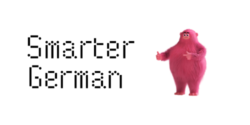
Summary
SmarterGerman is much different than every other language learning resource I’ve tried. Its Everyday German Course is made up of 12 parts that are five lessons a piece, each of which correspond with a chapter from a German crime story. Through these lessons, and lots of exercises, the course will help you reach the B1 level. Unlike most courses where there’s a lot of spoonfeeding of information, this course pushes you to use your critical thinking skills.
Michael, the course creator, is an excellent teacher
There are abundant exercises to practice every aspect of German.
Each level is $349 excl. VAT/GST. Up to 40% off with bundles. Ongoing Live Q&A sessions, completely free of charge.
I Like
- Michael’s teaching philosophy will not only help you improve your German but also your approach to language learning.
- The learning cycle will help you practice reading, writing, listening, speaking, vocabulary, and grammar.
- It’s a challenging course, even if you’ve already studied some German.
I Don’t Like
- It can be very intimidating as an absolute beginner to German.
- Students who aren’t very committed to studying German may struggle.
- It’s not the cheapest program.
Price
The Magnificent German Course Bundle (A1-C1) costs $699+ excl. VAT/GST. Or each level for $349. This comes with Live Q&A sessions with Michael himself. That said, you can also frequently get a discount like 40% off if you purchase multiple levels of the course at once
Table of Contents
I first heard about smarterGerman while putting together this huge list of 130+ resources to study German.
I was immediately intrigued by the video about using Amazon’s Alexa to help you study German. Upon taking a closer look at their Everyday German Course, I was encouraged by the number of lessons and all the components contained within each lesson.
So, in order to write a really in-depth review of the course, I decided to try it out myself.
I am a complete beginner in German. I probably only knew about ten words before starting the first lesson. I’ve only VERY briefly studied some of the absolute basics of German.
In total, I spent about 5 or 6 hours working through some of the early lessons of smarterGerman’s Everyday German course (A1-B1). I then spent another couple of hours jumping around to see how the structure of the upper levels compared with the lower ones.
In my experience of trying a ton of language learning resources, I haven’t ever used one quite like smarterGerman. This course is truly unique in its approach to teaching a language.
Some Basic Info About smarterGerman
Before taking a deep look at what’s contained within each lesson, I think it’d be helpful to give a broader overview of the Everyday German Course.
Throughout the course, there are 60 lessons divided into 12 parts. Each lesson corresponds with a short chapter of a crime story, “Die Tote Frau im Garten.”

The lessons are designed to take you from a beginner student up to the B1 level. Michael, the creator of sG claims that experienced language learners might be able to reach B1 in 90 days if they invested 3-4 hours daily.
It’s worth noting that this study time only includes the time you spend on the course. You’re highly encouraged to use the accompanying Memrise course. The time you spend studying with other resources, such as Glossika (though I prefer Speechling) or a tutor is also not included in the total study time.
Michael claims that a tutor is not really necessary when working with his courses unless one wants to specifically practice for the B1 oral exam. Although it may not be necessary, you would definitely benefit from occasional lessons with a tutor.
While the German government says that 2800 words are needed to reach the B1 level, Michael believes that it can be reached with only 1200 words.
While reaching B1 in 90 days may sound like an extremely ambitious claim, it’s worth noting that it would require a serious amount of effort to do so in that time.
Courses Available on smarterGerman
You can select a variety of different courses on smarterGerman. The basic courses focus on the language levels used by the CEFR, or Common European Framework of Reference, levels. This is the way most language programs talk about levels of fluency within a language. The levels include A1 and A2, B1 and B2, and C1 and C2
Another reason it is helpful to take a course specifically designed around these levels is that you may need to take a test to prove that you can speak fluently at that level, for work or to move to a new country.
Besides these leveled courses, you can also take specialty courses specifically designed to help you prep for the exams. Other specialty courses offered include German Grammar Genius, Unblock Your German, and several more.
As a beginner, you would probably want to start with the level A1 course. But it is helpful to know that the program offers more resources as you go.
My First Impression of smarterGerman
The course was created by Michael Schmitz. It quickly becomes obvious that Michael has a lot of teaching experience – not just in the way that the curriculum is designed but also by looking at his teaching methodology.
It doesn’t take long to see that he has no intention of teaching you every little thing that you find in other courses or grammar books. In most language learning courses, the content is spoon-fed to you. For other courses, it’s rare that you really need to logically think through problems and come up with an answer on your own.
If you think about other subjects you studied in school, the teachers that had the most impact were likely to be the ones that pushed you to think and solve problems for yourself. This is how Michael’s course works.
He doesn’t give you a list of vocab words to learn or tables to memorize. Instead, he creates a space for you to learn German. He’s more of a facilitator, there to help you out and explain things when necessary.
This is even evident in the comments section of the course. It’s not uncommon for someone to ask a question and for Michael to respond with a question of his own.
This isn’t the type of course that you can passively sit through and expect to get anything out of. It’s pretty exhausting to work through and requires you to keep pushing yourself forward.
It’s hard, but still very enjoyable.
As an absolute beginner starting out with the course. I quickly felt overwhelmed. I’m sure even if I had studied German before, I’d still have felt overwhelmed. But I felt a bit like I was being thrown right into the deep end.
But, bear with me, this isn’t as bad as it might sound. My initial reaction was just caused by how different Michael’s approach is compared with most language learning resources.
One of the first things you’re asked to do is to read the first chapter of the story as you’ll find it below.
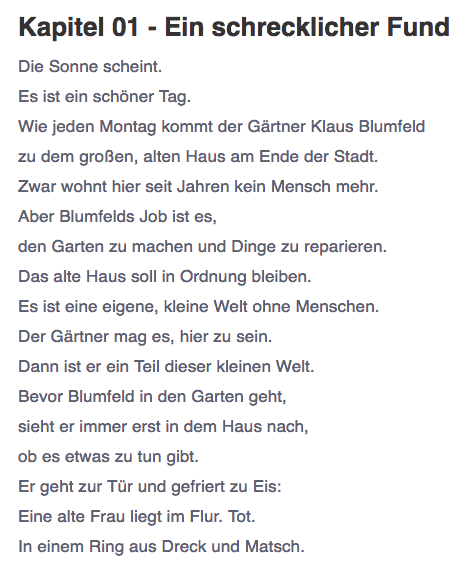
Needless to say, I understood almost nothing – at least that’s what I thought. Reading through the text again with translations, which is the second step to take, helped some, followed by another reading for understanding, and the final reading with audio made it a bit better still.
But it wasn’t until watching his analysis video that things really started to make sense. He takes the time to go through each text sentence by sentence to explain how the words are similar to English and different ways to analyze the text to get a better understanding and make educated guesses as to the meanings.
Instead of memorizing all of the words, it feels more like you’re learning how to figure out a text for yourself.
If you follow along with the Memrise course (as suggested) you’ll find yourself remembering much of the vocabulary and content of the course texts you’ve studied anyway.
Still, even if you do everything you’re suggested to do, and more, you’re likely to struggle through the course. I don’t say this as a negative, in fact, it’s the opposite. You’re likely to learn much more from a course in which you make mistakes, learn from them, and continue on compared with one that doesn’t require much deep thinking.
It’s seriously challenging but…
Seeing the comments of other students makes it clear that even if I had a bit of previous German knowledge that this would still be the case. Michael is quick to encourage students and relieve their performance anxiety.
He’ll often say that you shouldn’t aim to answer 100% of the questions correctly before moving on. He welcomes mistakes as part of the learning process. Throughout the course, you’ll also get better at correcting your own mistakes as that is what you are being encouraged and guided to do as part of the learning cycle Michael has created.
smarterGerman is mentally taxing at times. Going through the course can be exhausting – and that’s a good thing. Sure, you could try learning German by matching pictures to words with Duolingo or Rosetta Stone, but that’s easy. More often than not, you can answer questions on those platforms correctly without actually learning much German.
With smarterGerman it’s the opposite, you’ll learn more German but still make a lot of mistakes as you do so. These mistakes are what leads to your learning.
Lesson Components
Each lesson looks at a different chapter of the crime story, “Die Tote Frau im Garten.” With the help of this story, you’ll study all aspects of the German language.
Each lesson is structured pretty similarly, though many lessons have a few additional components such as extra articles and videos.
The lessons contain…
- Reading and learning vocabulary
- Writing a dictation
- Grammar
- Preaching
- Active listening
- Interactive exercises
- Writing
- Secretary technique
- Oral dictation
- Extras
I’ll now dig a bit deeper into each of these components for a detailed look at what it’s like to work through a lesson on smarterGerman’s Everyday German course.
Reading and learning vocabulary
Starting with reading and learning vocabulary in this manner was much different than I’d encountered in other courses. Instead of learning some key vocabulary before reading, you are simply given a text to work through.
The texts seem to become a bit longer and more difficult as you progress through the course. However, my German isn’t good enough to say that this is definitely the case.
Below you’ll find part of the text from Lesson 37.
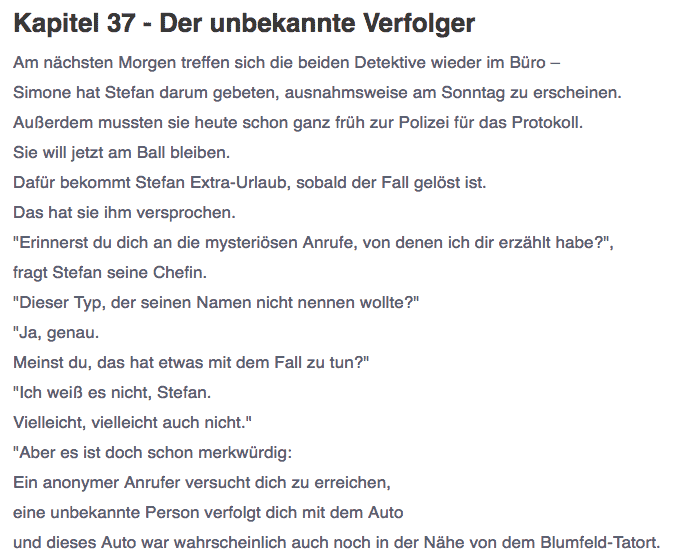
The first time you read, you aren’t meant to understand everything. There’s likely to be a lot that you don’t understand, which is completely normal and okay.
When you read the text, you’re meant to simply notice and mark any unknown words to get an overview of your current knowledge and the difficulty of the text.
Next, you’ll read the text for understanding.
Here, there’s a translation after each line. It’s a literal translation, so the English may seem a bit funny, but it makes it easier to understand the German. Michael suggests visualizing the sentences to make them easier to remember.
For example, if it says, “Thorsten drinks a sip of tea.” then imagine a man name Thorsten taking a small drink of tea. Try to make it a vivid image – Where’s he sitting? What’s he look like? What’s he wearing? Etc. This doesn’t take much time as images will come quickly to your mind and not every sentence needs to be visualized.
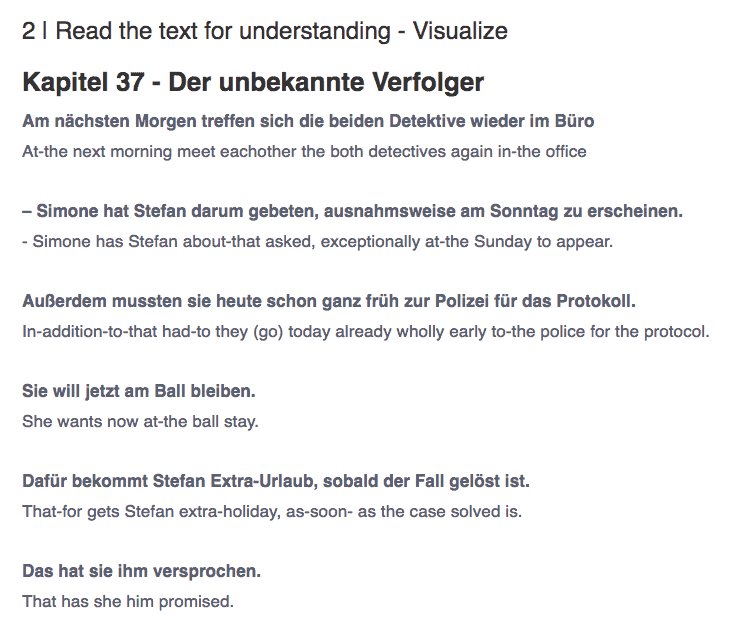
The third step is to read the text again.
Next, you’ll read the same text again without translations. As you read, you should try to bring to mind the visualizations you did in the previous step. This will make it easier to remember the meaning of each line.
After that, you’ll read the text one more time, but this time, you’ll listen to an audio recording of the text as you read.
This step will help you improve your pronunciation and hopefully, you’ll understand the text a bit better after this final reading. It’s alright to pause the audio a few times to make it easier for your brain to keep up.
You also have the option of adjusting the playback speed of the audio recording.
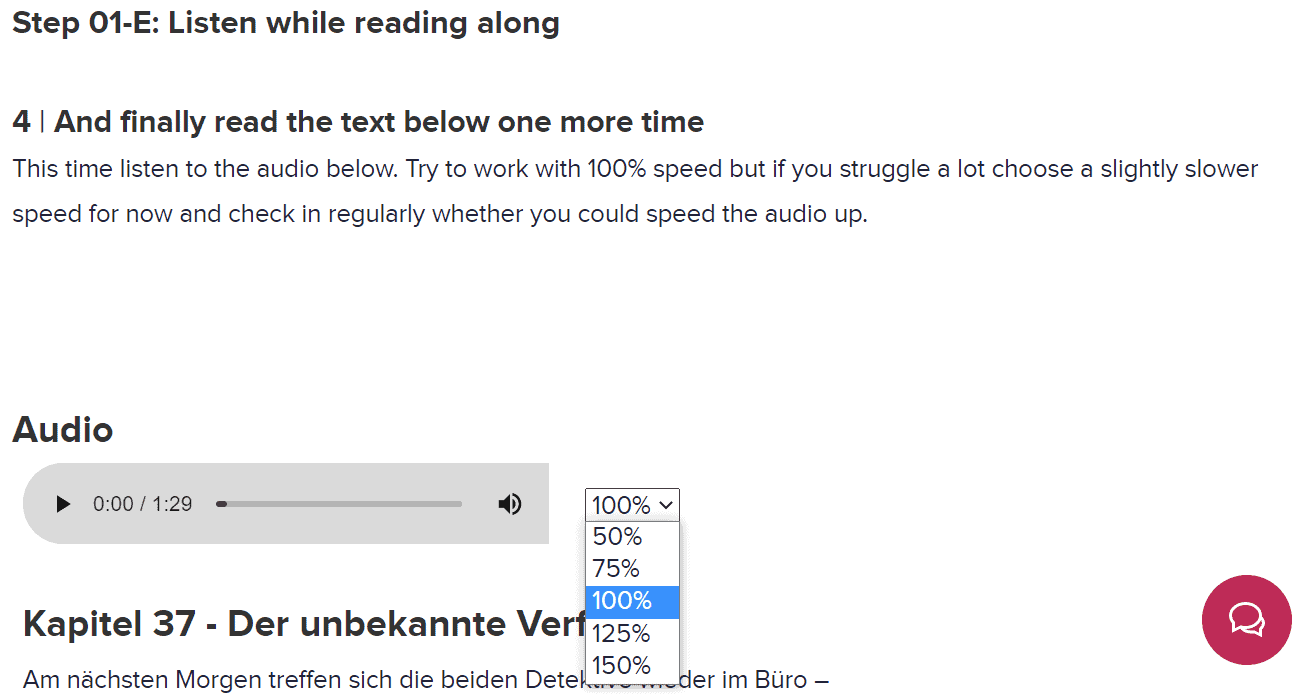
Following the fourth reading is a short multiple-choice comprehension quiz.
It’s very straightforward. You’ll be asked a few questions and need to answer it based on what you’ve read in the story.
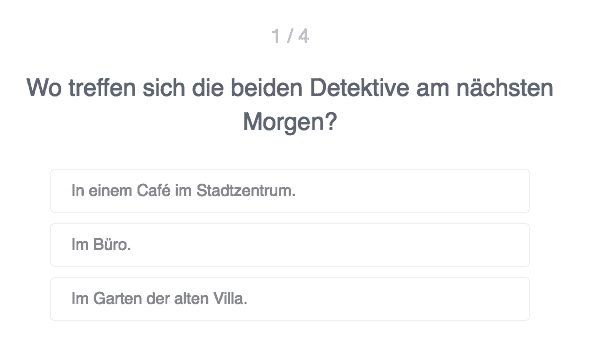
Finally, after all of this, there’s an analysis video which typically lasts somewhere between 20-40 minutes.
In the first two lessons that I studied, I still felt completely overwhelmed at this point because of my lack of prior German knowledge. The analysis video is said to be optional, but for nearly everyone, I’d recommend watching it – especially in the beginning.
In these videos, Michael takes you through the text one sentence at a time. Upon my first readings, I felt like I had absolutely no chance of understanding a text like this on my own. It was far too difficult for me.
But, seeing the way he breaks things down is super helpful. I didn’t realize how many words could be like English or how some spelling changes could make it easier to guess the word. He also gave simple suggestions such as removing the ending to try to figure out the words.
Of course, you won’t be able to understand every line of the text in this manner, but it’s a start. Michael adds so many useful observations in these videos. There are many things I wouldn’t have ever thought about on my own.
That’s the strength of Michael’s teaching method. It’s much more in the spirit of teaching you how to learn rather than merely telling you the answers.
Writing a dictation
The next step in the lessons is writing a dictation. The dictation will help nearly every area of your German – listening, reading, writing, and grammar.
For this step, you’ll take the audio from the current chapter which is provided within the lesson. Again, there are a few steps to this and the more you put into it, the more you’ll get out.
Here’s the description from Michael about how to approach the dictation exercises…
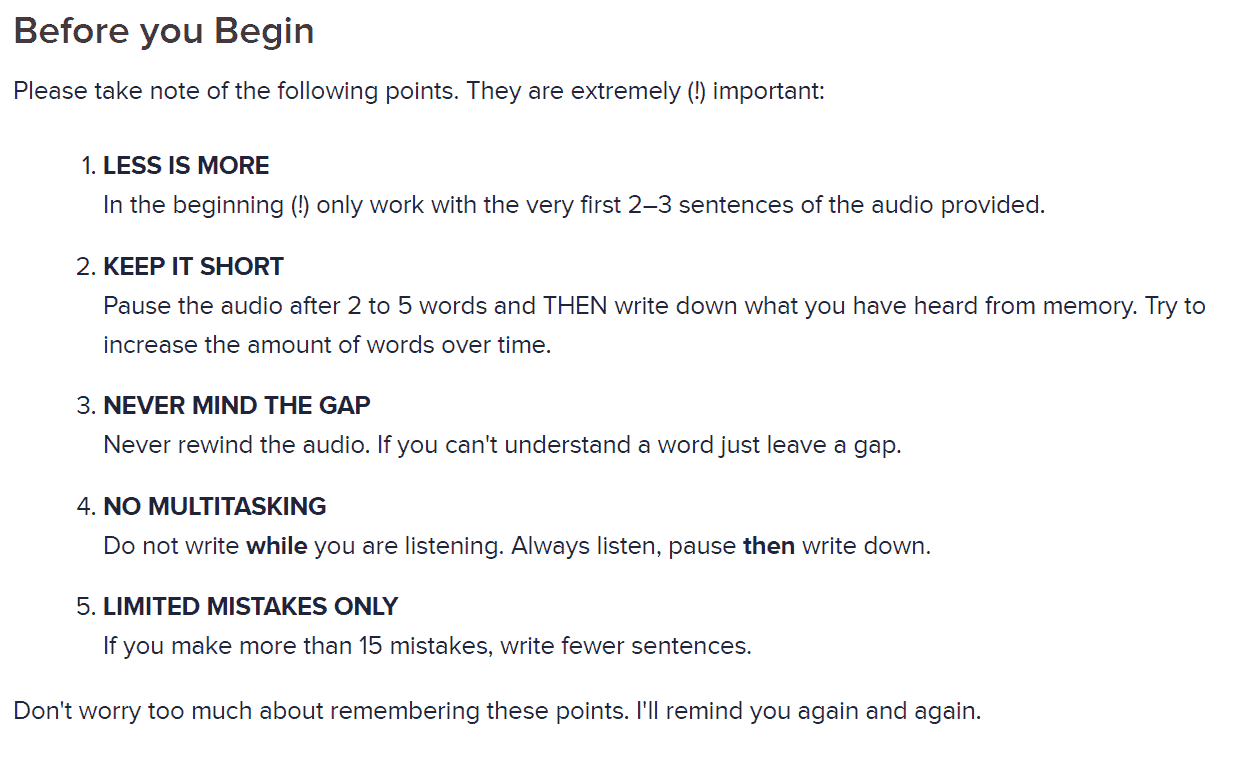
He mentions not to worry about trying to write all the sentences down and recommends beginners to pause every few words to write down what they’ve heard.
As you move through the course, or if you already have a higher level of German, you’ll be able to listen to longer portions of the chapter. In the beginning, just a few lines will likely be enough.
As a beginner myself, I found it to be really challenging. I’m sure if I had also tried to listen to full sentences or complete the entire text, that it would have taken me a really long time and been a frustrating experience.
You’ll listen to the audio twice in this manner, the second time filling in what you’ve missed on the first listen.
After a first run-through, you’ll quickly come across a second dictation exercise with the same audio. Again, I’ll let Michael explain…
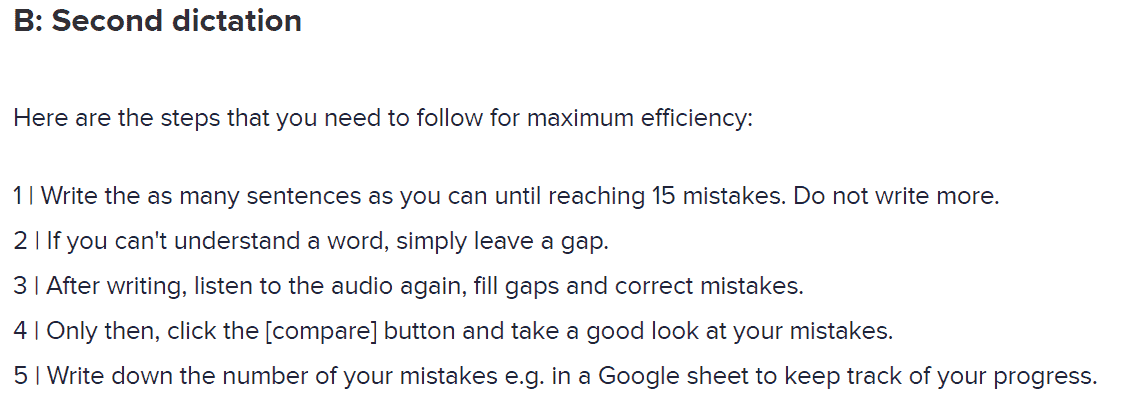
In this step, you’ll compare your writing with the text from the chapter. I highly recommend following Michael’s advice.
There’s an incredibly handy function in these dictations: you’re able to type your transcription into a box in the platform and have it graded by the computer.
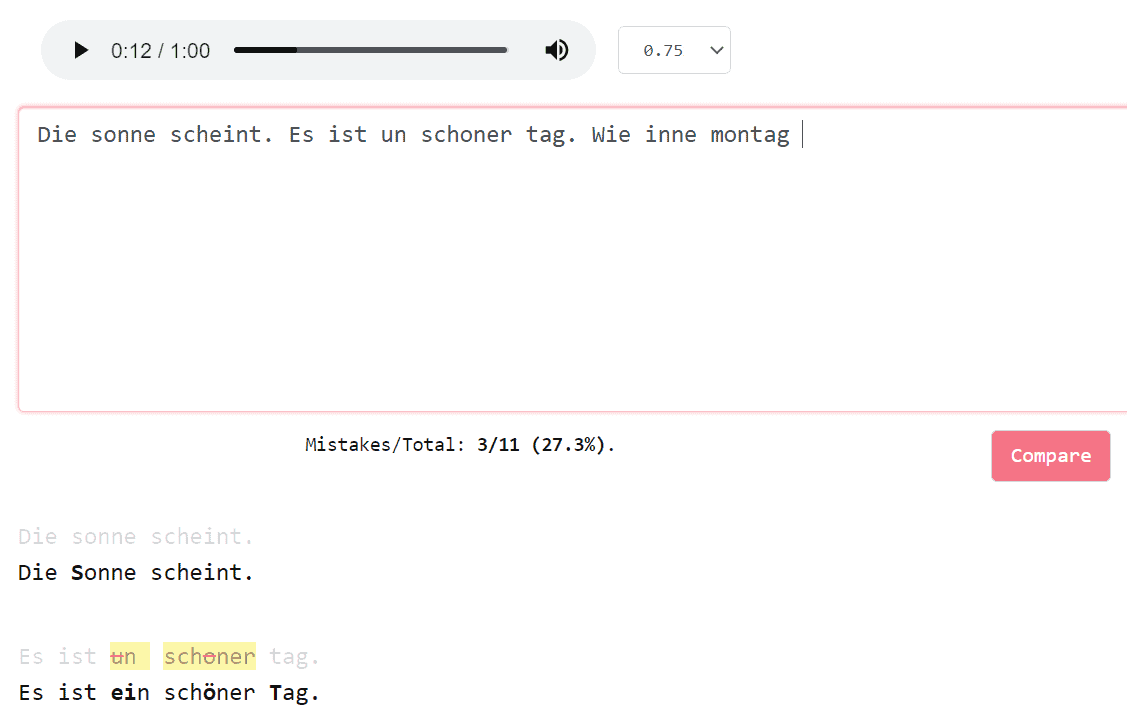
You can also adjust the speed of the playback, toggle the play/pause button with hotkeys, and easily input special German characters. The system works well, and it makes it super easy to find your mistakes.
For me, I hadn’t spent much time learning German pronunciation before taking these lessons.
So, several of my mistakes came from a lack of knowing how German sounds and letters correspond to each other.
If you’d like some extra help, I’d suggest occasionally working with a tutor or language exchange partner in addition to this course.
I’ve found that italki is easily the most convenient and affordable place to find a tutor. They also have some additional free features that are really useful. For example, there’s an Exercise section where you can have your writing corrected by a native speaker, you can also post general questions related to learning German, and there are lots of people that are interested in doing language exchanges.
The third round of the dictation is exactly the same as the rounds before. Except now, you’ll want to wait a few hours before trying it a third time. I found rather large improvements from following the earlier steps and then coming back for a third attempt.
Again, the goal here isn’t to get everything correct. You don’t need to have mastered the text before moving on and you’ll likely still have a lot of questions at this point.
With a lot of other courses, you may expect to be able to answer 95% or more of the questions correctly, but that’s not how smarterGerman works. You’ll likely have made lots of mistakes, but that’s alright and it’ll get better as you move through the lessons.
Grammar
Many language learners feel that grammar is difficult and boring. In my own studies, I’ve found that learning grammar really simplifies things and makes life much easier.
That seems to be Michael’s philosophy as well. He recommends using grammar to relax. While I may not go as far as to call grammar relaxing, there’s no reason for people to dread studying it. Learning grammar can save you a ton of time and help avoid countless misunderstandings.
The grammar lessons on smarterGerman are meant to take about 15-20 minutes to complete.
The first part is always a short video, typically between 2-6 minutes long, in which Michael explains the grammar point. There is also always a written explanation below each video but you should still both watch the video and read the text.
One thing you’ll notice from the videos is that they appear to have been recorded over a span of several years as Michael’s appearance changes throughout them.
I believe the videos may have been originally recorded for his YouTube channel before he decided to put together this course.
This doesn’t matter all that much but was initially a bit surprising to see the changes in his appearance with each video that I watched.
After learning about the grammar point, you will practice it by answering some multiple-choice questions.
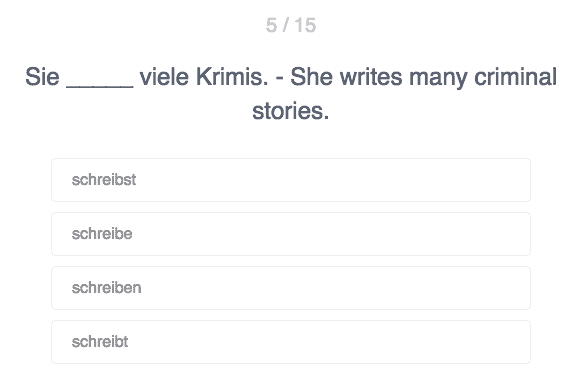
Preaching
The next step in the course is called Preaching. This is a method that basically drills grammar structures into your head by practicing speaking sentences using them.
Like most things in this course, Michael provides the structure, explanations, and examples for you to do it, but it’s actually on you to follow through and complete each exercise.
With this technique, you’ll first need to write some triggers on a piece of paper, notecard, or anywhere else really, or if available, could use Alexa to assist you in your preaching. You’ll need to learn the gender for each of these triggers before you can start the main exercise.
As an example, for the preaching component of exercise 1, Michael used the following words as triggers –
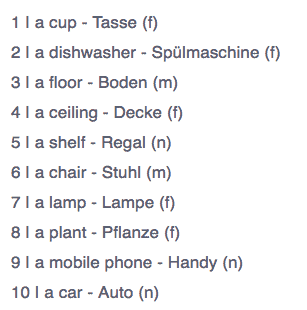
You’ll then want to memorize the gender of each of these words and write them down. This exercise will help you to form grammatically correct sentences using as few words as possible. His example sentences using the above words were…
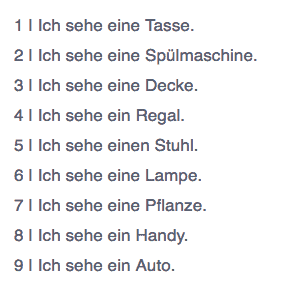
The goal is to create your own sentences and get comfortable speaking them out loud.
So, you’ll want to think of your own triggers. There’s no need to actually write the full sentence down anywhere. You’ll simply see the trigger word and then say the sentence.
While everyone will be a bit different, Michael recommends preaching at least twice per day for around 10 minutes each time.
He also recommends using transcription software like speechnotes.com which automatically transcribes what you say out loud. This gives you some free and easy feedback about how clear you’re speaking and about some more obvious grammatical issues of yours.
You should also record yourself every now and then so that you can hear your own speech. If you’re able to have a tutor look over your recordings occasionally, that would also be helpful.
It may be worth using Speechling for this task. It’s a service that lets you get feedback on your pronunciation from a native German teacher. Typically, you record yourself mimicking sentences, but you can also use the freestyle mode where you record any sentence you’d like.
Active Listening
Here, the instructions for the active listening section are pretty simple.
You’ll listen to the same text that you used in the previous exercises. By now you’ll likely be somewhat familiar with it, though if you’re like me, you’ll find that there are still lots of spots that you’re not exactly sure what is being said.
Basically, you’ll listen to the text again. The first time that you listen, you’ll almost certainly want to pause often to digest what was said and maybe to look up the meanings of some words that you forgot.
The second time you listen, you’ll want to pause a bit less often. By the end, you’ll want to listen to it fully without stopping and be able to understand most of it.
Again, there’s no need to feel stressed or overdo it if you struggle with some parts. Afterward, you’ll have to answer some multiple-choice questions about the text.
Interactive Exercises
We’re not yet done working on this lesson’s chapter of “Die Tote Frau im Garten.”
In this next step, you’ll be given the chapter with some words missing.
First, you’ll read each sentence and try to guess the missing word. If you’re not sure, you can click on the hint to help you figure it out. Finally, you can listen to the audio to confirm your answers and to fill in any that are still missing.
You aren’t given a word bank, so you’ll have to remember the correct spelling. When you finish, you can submit your answers to receive a score and also show all the correct answers.
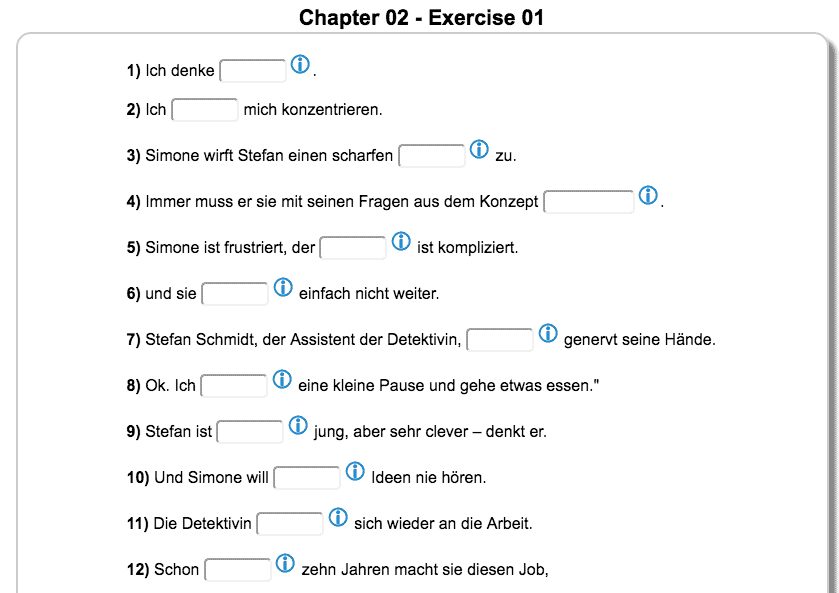
As you get further into the course, additional exercises will be added, including a writing exercise (starting in lesson 13), the secretary technique (starting in lesson 27) and an oral dictation (starting in lesson 31).
Writing
For this section, you’ll want to start out by writing short texts, only around 40 words to start. As you go further into the course, you can slowly make them a bit longer.
First, you’ll want to find a topic to write about. Michael gives you lots of suggestions but I’m sure you could also write about something else you’re interested in.
Then, you’ll write the first draft in English or your mother tongue. After that, you’ll want to simplify it so that it’s easier to translate.
Next, you’ll translate your simplified text into German WITHOUT using a dictionary. If you don’t know a word in German, you’ll write it in English.
After finishing the writing, you can go and look up the words that you didn’t know with a dictionary and add them.
You’ll then want to take a break before going back in and making any corrections to your text. You’ll go through it a few more times, checking for different things like verb endings and personal pronouns.
If you have a tutor, it’d be smart to have them read through your writing and check it for errors but Michael has a very clear idea about what a proper correction looks like. He suggests that you should never get presented with the correct answer to your mistakes right away. It is sufficient if your corrector simply highlights the words that are incorrect.
You can also enroll in smarterGerman’s corrections service to have your writing exercises corrected on a regular basis, but it does cost an additional $110.
Another great option, which is completely free, is to post it into the Exercise section of italki. Then, a native German speaker will come in and give you feedback on your writing. The downside of using italki for this is that people will go ahead and correct your mistakes for you, taking away the learning opportunity.
A third option for feedback, with a smaller community but a great design, is LangCorrect. It’s totally free to use.
Secretary Technique
The Secretary Technique is much like the Preaching exercises you did earlier in the lessons.
Here, you’ll think about a topic that you can talk about for up to two minutes. You’ll then write up to ten keyword triggers to help you remember what you’d like to talk about next.
Then, with the help of a tutor, language exchange partner, or an app like speechnotes.com, you’ll record yourself speaking about the topic, using your triggers to guide you.
After you’ve finished speaking, you’ll look at your transcription and, if you decide to record yourself, listen to the recording. Recording yourself is optional and very work intense. So Michael advises you to only do it occasionally. You can go through them and notice any mistakes. You can then correct them as you did in the writing step earlier.
You’ll want to practice a 2nd or even 3rd time as well. In total, this should take around 30-45 minutes to complete.
I really like this exercise and think that it’s an excellent way to improve many aspects of your German.
Oral Dictation
With the oral dictation, you’ll work with your current chapter “Die Tote Frau im Garten” text that you’ve been using throughout the lesson.
I’ll share Michael’s explanation for how this works…
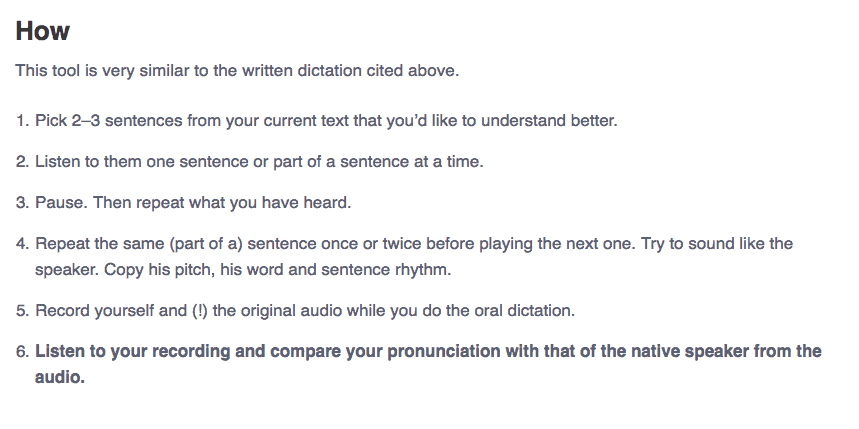
It’s important that you record both yourself and the original audio together at the same time.
That makes it easier to notice the differences between yourself and the recording.
Modeling a native speaker in this method is extremely useful for improving your speaking rhythm and pronunciation.
I’ve mentioned Speechling before, but it’s worth mentioning again here. I think it’s an excellent tool, even if you don’t upgrade to a paid plan. For free, you can listen to lots of sentences and record yourself saying the same sentence.
What I really like is that your recording then becomes sandwiched between the native speakers. So, you’ll hear a recording, then you’ll record yourself saying the same thing, and after that, you’ll hear the native speakers recording again.
It’s a really effective way to improve your flow, pronunciation, and overall confidence in speaking German.
Extras
Besides the main components of each lesson, there’s still quite a bit of extra stuff that’s worth talking about.
First, Michael gives tons of great advice for learning German. This is in the form of articles and videos around lots of different topics like overcoming your fear of speaking German, taking breaks, whether or not your expectations are realistic, and a bunch more.
Another well-planned aspect of this course is that after every five lessons, there are two review lessons.
Next, Michael has gone ahead and created a Memrise course that corresponds to the text of each lesson. Memrise is basically smart flashcards that are a bit more fun. Cards show up to be reviewed at intervals that make it hard to forget and don’t waste your time on things you already know by heart.
In the Memrise course, Michael has split up the chapters of the story into small chunks of a few words each. Each flashcard also has audio and translations. Reviewing in this manner helps you remember words within their context.
I would strongly suggest following along with the course using Memrise.
How Much Does smarterGerman Cost?
smarterGerman pricing structure is $249 per each level (A1, A2, B1, and so forth), and up to 40% off with multiple level bundles.
SmarterGerman’s Michael has ongoing Live Q&A sessions all the time, for free, so you can ask questions directly to Michael. Also, Michael is known to spontaneously suggest in-person meetups when he is traveling abroad (or in his hometown, Berlin), and I hope someday I get to meet Michael somewhere in the world.
You can try the intro and the first lesson of the course for free. And, if you do end up buying the course but decide it isn’t right for you, you can get a full refund within the first 30 days. All you need to do is write a short email to Michael within those 30 days. There are a few specific challenge courses available as well, and they also come with the 30-day money back guarantee.
How to Use smarterGerman to Learn German
smarterGerman is a really rich learning program with a lot to offer. Check out these tips to get the most out of your learning experience!
Make sure to practice speaking German
While you will practice lots of useful conversational phrases throughout the program, especially in the Preaching section, you will not actually engage in a real-life conversation. This is a key part of learning a language. If you don’t have people in your life who speak German, don’t worry! You can easily find German conversation partners online.
Try free apps like HelloTalk, which connects you with German speakers who also want to learn English. This way, you can both practice your brand-new language skills without any embarrassment. You can even tell your partner what you are learning in smarterGerman that day, and ask to practice conversation on that topic.
Don’t be afraid to work through the course step by step
You have probably noticed this theme multiple times in this article, but it is worth repeating: you will get out of the program what you put in. You really have to commit to each of the activities.
For example, if you just glance at the story text in German and tell yourself, “I can’t read that,” then you will not learn anything. If you follow Michael’s advice and begin to look for words you know, or words that relate to English words, you will slowly begin to gain the ability to read in German!
When you’re used to fast-moving apps like Instagram, TikTok, or even gamified language programs like Duolingo, it can feel tough to slow down and approach each activity with a spirit of invested learning. But this is what will truly help you gain each level of fluency in smarterGerman.
Immerse yourself in the German audio
You will find lots of audio to listen to as well as longer videos you can watch within the smarterGerman course. That said, one of the best ways to speed up your race to fluency in German is to immerse yourself in the language.
Besides committing to your daily lesson time, try adding several fun or background elements of German into your daily life. This could look like watching a German movie to relax in the evening, or listening to German rap as you jog around the neighborhood.
The more you listen to German, the faster you will pick up the unique sounds and structure of the language!
Set Goals
Finally, smarterGerman is pretty intense for a beginner. It doesn’t have all the tiny dopamine bursts you get from a gamified program like Duolingo, either. Because of this you may want to set yourself a list of goals and rewards as you work through the program, to help keep you motivated.
For example, you could reward yourself with something little like a piece of candy or a five-minute break to pet your dog every time you complete a lesson element like the secretary or dictation activities. Or you could set bigger goals, like rewarding yourself with an episode of your favorite show every time you finish a whole lesson.
Alternatives to smarterGerman
Honestly, smarterGerman is one of the most comprehensive and useful German programs out there. But you may want to look into alternatives for several reasons. First, smarterGerman is very pricey compared to lots of other language-learning programs. If you can’t afford that price point, we have several great alternatives here.
Second, smarterGerman focuses on truly teaching you German, in all aspects, to the point that you could pass a fluency test at each level. Many other language-learning programs focus on different goals. Some aim to teach you travel-level German, so you can get around on a trip. Others focus mostly on conversation skills, to help you communicate in real-life situations.
Pimsleur German App
One of the oldest and best app-based German courses out there is offered by the venerable language-learning program Pimsleur. This program focuses on listening comprehension and conversation. It uses a method called Spaced Repetition to help you build a strong foundation in key vocabulary, without pointlessly memorizing hundreds of words.
Pimsleur does a great job getting you speaking and understanding German in a short time frame. It doesn’t do a deep dive into grammar or culture, though. However it does use a direct speech software that lets you practice your new language skills out loud.
Pimsleur is not super cheap as the German course has a monthly subscription of $19.95, but it is less costly than smarterGerman. You can check out Pimsleur’s German course here!
Storylearning German Uncovered
Storylearning teaches you German through an ongoing story. This is a bit similar to smarterGerman, but has more focus on the narrative. In each chapter, you read, listen to, and then translate the next portion of the narrative. Then you go through six or seven lessons based on the topic covered in that portion of the story, diving into grammar, culture, literacy, and more.
Storylearning works great for anyone who struggles with the super-detailed or textbook-style learning. It uses the concept that people communicate naturally through storytelling, which makes learning a language easier in story form.
In comparison to smarterGerman, Story Learning is a bit less intense. It does offer professional tutor-presented videos on German grammar and other elements of the language, but they don’t get as involved or cover quite as much. Also, Storylearning is not tailored specifically to the CEFR levels like smarterGerman. Storylearning does cost slightly less, with a one-time payment of $297. Check out Storylearning’s German Uncovered course here!
GermanPod101
If your favorite part of the smarterGerman course is Michael’s videos, you may like the free GermandPod101 course even better! This course features videos and podcast-style audio lessons on hundreds of different topics, ranging from emergency German for medical situations to German with family members.
You can also get into much more complex videos about grammar when you’re ready to dive into the foundations of the language.
If you sign up for a paid version, you can access additional resources like lesson transcripts and some activities. However, this program is mostly just audio and video-based, without the intense level of work you have to put into a program like smarterGerman. It would work best for someone who has an audio learning style and lacks the attention span necessary for smarterGerman. Check out GermanPod101 here!
Ouino German
Ouino German has a self-directed style that lets you work through lessons and topics at your own discretion. It also takes a unique approach because it is not designed as a fully self contained course. The program tells you honestly that it serves as the core of your learning system, but works best when paired with enrichment resources.
Ouino offers lots of sleek features like a chance for you to record yourself speaking, and then listen to native German speakers say the same phrase for comparison.
In comparison to smarterGerman, it lacks the CEFR-leveled approach. It also doesn’t go quite as in-depth into grammar and some other topics. However, it will give you a solid overview of German, especially as a beginner. Plus, Ouino German costs just $95.76 for lifetime access to the course. Check out Ouino German here!
Final Thoughts
I was really impressed with smarterGerman. It’s definitely a good course.
I was also really surprised. Although I’ve tried out tons of language learning resources and courses, I’ve never actually taken a course quite like smarterGerman.
I’ve never seen a course that really guides you to teach yourself. Most others will give you lots of information but require very little if any, critical thinking.
The lessons on smarterGerman are really exhausting to go through. They’re far more challenging than you’ll find in other courses.

The techniques in this course can help you learn to be your own teacher. Of course, you’ll still need some help from others since you’re not yet a fluent German speaker.
It’s also unique in that it’s suitable for both beginners and even those who have already studied a fair amount of German.
For absolute beginners, it’ll be very intimidating in the beginning, but it’s still doable. It wouldn’t hurt to study a little bit with some other resources first, but I don’t think it’s necessary to do so. You’ll start to pick up on things very quickly.
However, you may find a program like Ouino or Pimsleur’s German courses less overwhelming as a total beginner.
For those with a bit higher German level, I still think you’d get a lot out of this course. The strategies you’ll learn will be helpful forever. Plus, since it’s not structured in the typical way of most courses, you’ll learn a lot of different things.
Overall, I was really impressed with smarterGerman. If you’ve read this far and think it might be a good fit, I’d suggest trying the first lesson as it’s free to do so.

